西方文化导论专有名词中文翻译
西方文化入门
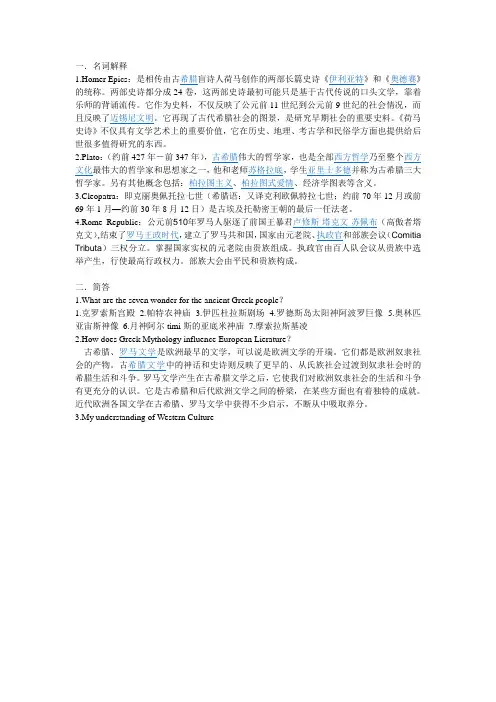
一.名词解释1.Homer Epics:是相传由古希腊盲诗人荷马创作的两部长篇史诗《伊利亚特》和《奥德赛》的统称。
两部史诗都分成24卷,这两部史诗最初可能只是基于古代传说的口头文学,靠着乐师的背诵流传。
它作为史料,不仅反映了公元前11世纪到公元前9世纪的社会情况,而且反映了迈锡尼文明。
它再现了古代希腊社会的图景,是研究早期社会的重要史料。
《荷马史诗》不仅具有文学艺术上的重要价值,它在历史、地理、考古学和民俗学方面也提供给后世很多值得研究的东西。
2.Plato:(约前427年-前347年),古希腊伟大的哲学家,也是全部西方哲学乃至整个西方文化最伟大的哲学家和思想家之一,他和老师苏格拉底,学生亚里士多德并称为古希腊三大哲学家。
另有其他概念包括:柏拉图主义、柏拉图式爱情、经济学图表等含义。
3.Cleopatra:即克丽奥佩托拉七世(希腊语:又译克利欧佩特拉七世;约前70年12月或前69年1月—约前30年8月12日)是古埃及托勒密王朝的最后一任法老。
4.Rome Republic:公元前510年罗马人驱逐了前国王暴君卢修斯·塔克文·苏佩布(高傲者塔克文),结束了罗马王政时代,建立了罗马共和国,国家由元老院、执政官和部族会议(Comitia Tributa)三权分立。
掌握国家实权的元老院由贵族组成。
执政官由百人队会议从贵族中选举产生,行使最高行政权力。
部族大会由平民和贵族构成。
二.简答1.What are the seven wonder for the ancient Greek people?1.克罗索斯宫殿2.帕特农神庙3.伊匹杜拉斯剧场4.罗德斯岛太阳神阿波罗巨像5.奥林匹亚宙斯神像6.月神阿尔timi斯的亚底米神庙7.摩索拉斯基凌2.How does Greek Mythology influence European Lierature?古希腊、罗马文学是欧洲最早的文学,可以说是欧洲文学的开端。
欧洲文化入门51个名词解释
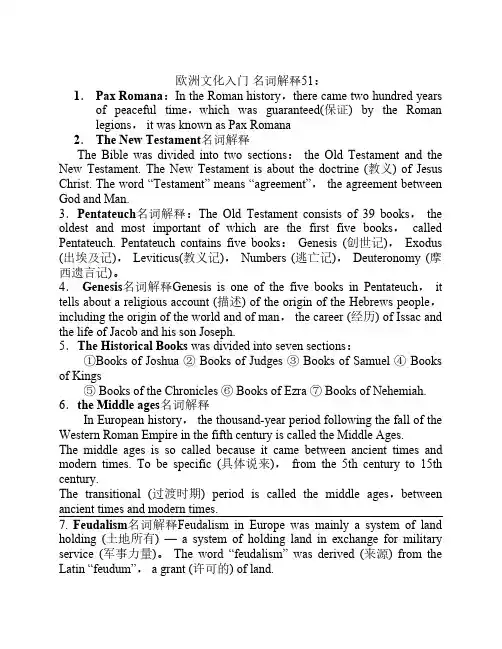
欧洲文化入门名词解释51:1. Pax Romana:In the Roman history,there came two hundred years of peaceful time,which was guaranteed(保证) by the Roman legions, it was known as Pax Romana2. The New Testament名词解释The Bible was divided into two sections:the Old Testament and the New Testament. The New Testament is about the doctrine (教义) of Jesus Christ. The word “Testament” means “agreement”, the agreement between God and Man.3.Pentateuch名词解释:The Old Testament consists of 39 books,the oldest and most important of which are the first five books,called Pentateuch. Pentateuch contains five books:Genesis (创世记),Exodus (出埃及记),Leviticus(教义记),Numbers (逃亡记),Deuteronomy (摩西遗言记)。
4.Genesis名词解释Genesis is one of the five books in Pentateuch,it tells about a religious account (描述) of the origin of the Hebrews people,including the origin of the world and of man, the career (经历) of Issac and the life of Jacob and his son Joseph.5.The Historical Books was divided into seven sections: ①Books of Joshua ② Books of Judges ③ Books of Samuel ④ Books of Kings ⑤ Books of the Chronicles ⑥ Books of Ezra ⑦ Books of Nehemiah. 6.the Middle ages名词解释 In European history, the thousand-year period following the fall of the Western Roman Empire in the fifth century is called the Middle Ages.The middle ages is so called because it came between ancient times and modern times. To be specific (具体说来),from the 5th century to 15th century.The transitional (过渡时期) period is called the middle ages,between ancient times and modern times.7. Feudalism名词解释Feudalism in Europe was mainly a system of land holding (土地所有) — a system of holding land in exchange for military service (军事力量)。
西方文化导论
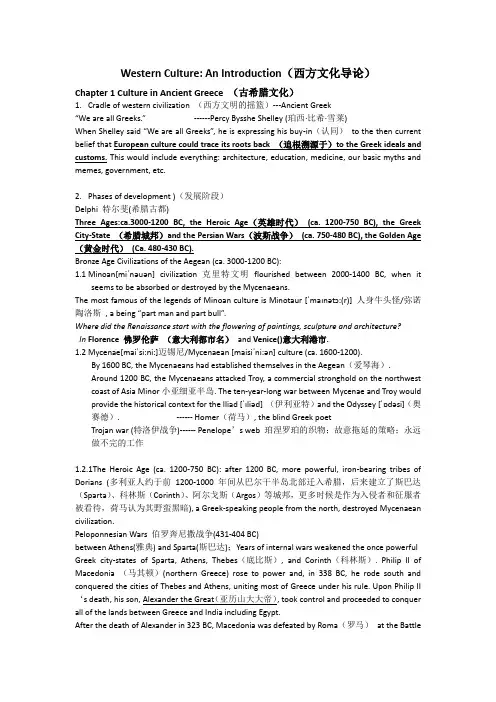
Western Culture: An Introduction(西方文化导论)Chapter 1 Culture in Ancient Greece (古希腊文化)1.Cradle of western civilization (西方文明的摇篮)---Ancient Greek“We are all Greeks.”------Percy Bysshe Shelley (珀西·比希·雪莱)When Shelley said “We are all Greeks”, he is expressing his buy-in(认同)to the then current belief that European culture could trace its roots back (追根溯源于)to the Greek ideals and customs. This would include everything: architecture, education, medicine, our basic myths and memes, government, etc.2.Phases of development )(发展阶段)Delphi 特尔斐(希腊古都)Three Ages:ca.3000-1200 BC, the Heroic Age(英雄时代)(ca. 1200-750 BC), the Greek City-State (希腊城邦)and the Persian Wars(波斯战争)(ca. 750-480 BC), the Golden Age (黄金时代)(Ca. 480-430 BC).Bronze Age Civilizations of the Aegean (ca. 3000-1200 BC):1.1Minoan[miˈnəuən] civilization 克里特文明flourished between 2000-1400 BC, when itseems to be absorbed or destroyed by the Mycenaeans.The most famous of the leg ends of Minoan culture is Minotaur [ˈmaɪnətɔ:(r)] 人身牛头怪/弥诺陶洛斯, a being “part man and part bull”.Where did the Renaissance start with the flowering of paintings, sculpture and architecture?In Florence 佛罗伦萨(意大利都市名)and Venice()意大利港市.1.2Mycenae[maiˈsi:ni:]迈锡尼/Mycenaean [maisiˈni:ən] culture (ca. 1600-1200).By 1600 BC, the Mycenaeans had established themselves in the Aegean(爱琴海).Around 1200 BC, the Mycenaeans attacked Troy, a commercial stronghold on the northwest coast of Asia Minor小亚细亚半岛. The ten-year-long war between Mycenae and Troy would provide the historical context for the Iliad [ˈɪliəd] (伊利亚特)and the Odyssey [ˈɒdəsi](奥赛德). ------ Homer(荷马), the blind Greek poetTrojan war (特洛伊战争)------ Penelope’s web 珀涅罗珀的织物;故意拖延的策略;永远做不完的工作1.2.1The Heroic Age (ca. 1200-750 BC): after 1200 BC, more powerful, iron-bearing tribes of Dorians (多利亚人约于前1200-1000年间从巴尔干半岛北部迁入希腊,后来建立了斯巴达(Sparta)、科林斯(Corinth)、阿尔戈斯(Argos)等城邦,更多时候是作为入侵者和征服者被看待,荷马认为其野蛮黑暗), a Greek-speaking people from the north, destroyed Mycenaean civilization.Peloponnesian Wars 伯罗奔尼撒战争(431-404 BC)between Athens(雅典) and Sparta(斯巴达);Years of internal wars weakened the once powerful Greek city-states of Sparta, Athens, Thebes(底比斯), and Corinth(科林斯). Philip II of Macedonia (马其顿)(northern Greece) rose to power and, in 338 BC, he rode south and conquered the cities of Thebes and Athens, uniting most of Greece under his rule. Upon Philip II ‘s death, his son, Alexander the Great(亚历山大大帝), took control and proceeded to conquer all of the lands between Greece and India including Egypt.After the death of Alexander in 323 BC, Macedonia was defeated by Roma(罗马)at the Battleof Cynoscephalae(基诺斯山战役)in 197 BC and then again at the Battle of Pydna(皮德纳战役)in 168 BC. The Greeks were finally defeated at the Battle of Corinth in 146 BC. Rome completely destroyed and plundered(掠夺)the city of Corinth as an example to other Greek cities.1.2.2The Greek City-State and the Persian Wars (ca. 750-480 BC)In 490 BC, Battle of Marathon 马拉松战役In 480 BC, Battle of the Hot Gates and Battle of Salamis 萨拉米斯海战Persian Wars(希波战争): Herodotus 希罗多德(ca. 485-425 BC), the father of history 历史之父。
英美文学专有名词术语解释

Literary Terms(文学术语解释)*Legend(传说): A song or narrative handed down from the past, legend differs from myths on the basis of the elements of historical truth they contain.*Epic(史诗): 1)Epic, in poetry, refers to a long work dealing with the actions of gods and heroes. 2)Beowulf is the greatest national epic of the Anglo-Saxons. John Milton wrote three great epics: Paradise Lost, Paradise Regained and Samson Agonistes.*Romance(罗曼史/骑士文学): 1)Romance is a popular literary form in the medieval England. 2)It sings knightly adventures or other heroic deeds. 3)Chivalry(such as bravery, honor, generosity, loyalty and kindness to the weak and poor) is the spirit of romance. *Ballad(民谣): 1)Ballad is a story in poetic form to be sung or recited. 2)Ballads were passed down from generation to generation. 3)Robin Hood is a famous ballad singing the goods of Robin Hood. Coleridge’s The Rime of the Ancient Mariner is a 19th century English ballad.*The Heroic Couplet(英雄对偶句):1)It means a pair of lines of a type once common in English poetry, in other words, it means iambic pentameter rhymed in two lines. 2)The rhyme is masculine. 3)Use of the heroic couplet was first pioneered by Geoffrey Chaucer.*Humanism(人文主义):1)Humanism is the essence of the Renaissance. It emphasizes the dignity of human beings and the importance of the present life. 2)Humanists voiced their beliefs that man was the center of the universe and man did not only have the right to enjoy the beauty of the present life, but had the ability to prefect himself and to perform wonders.*Renaissance(文艺复兴):1)It refers to the transitional period from the medieval to the modern world. It first started in Italy in the 14th century. 2)The Renaissance means rebirth or revival. 3)It was stimulated by a series of historical events, such as the rediscovery of ancient Roman and Greek classics, the new discoveries in geography and astrology, the religious reformation and the economic expansion. 4)Humanism is the essence of Renaissance. 5)The English Renaissance didn’t begin until the reign of Henry Ⅷ. It was reg arded as England’s Golden Age, especially in literature. 6)The real mainstream of the English Renaissance is the Elizabethan drama. 7)This period produced such literary giants as Shakespeare, Spenser, Marlowe, Bacon, Donne and Milton, etc.*University Wits(大学才子): 1)It refers to a group of scholars during the Elizabethan age who graduate from either Oxford or Cambridge. They came to London with the ambition to become professional writers. Some of them later become famous poets and playwrights. 2)Thomas Greene, John Lily and Christopher Marlowe were among them. 3)They paved the way, to some degree, for the coming of Shakespeare.*Blank verse(无韵体):1)It is verse written in unrhymed iambic pentameter. 2)It is the verse form used in some of the greatest English poetry, including that of William Shakespeare and John Milton.*Spenserian Stanza(斯宾塞诗节):1)It is the creation of Edmund Spenser. 2)It refers to a stanza of nine lines, with the first eight lines in iambic pentameter and the last line in iambic hexameter(六音步),r hyming ababbcbcc. 3)Spenser’s The Faerie Queene was written in this kind of stanza.*Sonnet(十四行诗)1)It is the one of the most conventional and influential forms of poetry in English.2)A sonnet is a lyric consisting of 14 lines, usually in iambic pentameter, restricted to a definite rhyme scheme.3)Shakespeare’s sonnets are well-known. *Soliloquy(独白)1)Soliloquy, in drama, means a moment when a character is alone and speaks his or her thoughts aloud. 2)In the line “To be, or not to be, that is the question”, which begins the famous soliloquy from Act3, Scene1 of Shakespeare’s Hamlet. In this soliloquy Hamlet questions whether or not life is worth living and speaks of the reasons why he does not end his life.*Metaphysical Poets(玄学派诗人):They refer to a group of religious poets in the first half of the 17th century whose works were characterized by their wit, imaginative picturing, compressions, often cryptic expression, play of paradoxes and juxtapositions of metaphor.*Enlightenment Movement(启蒙运动)1)It was a progressive intellectual movement which flourished in France and swept through Western Europe in the 18th century.2)The movement was a furtherance of the Renaissance from 14th century to the mid-17th century.3)Its purpose was to enlighten the whole world with the light of modern philosophical and artistic ideas.4)It celebrated reason or nationality, equality and science. It advocated universal education. Literature at the time became a very popular means of public education.5)Famous among the great enlighteners in England were those great writers like John Dryden, Pope, Johnson, Swift, Defoe, Fielding, Sheridan, etc.Neoclassicism(新古典主义)1)In the field of literature, the 18th century Enlightenment Movement brought about a revival of interest in the old classical works. This tendency is known as neoclassicism.2)The neoclassicists hold that forms of literature were to be modeled after the classical works of the ancient Greek and Roman writers such as Homer and Virgil and those of the contemporary French ones.3)They believed that the artistic ideas should be order, logic, restrained emotion and accuracy, and that literature should be judged in terms of its service to humanity*Sentimentalism(感伤主义文学)1)It is a pejorative term to describe false or superficial emotion, assumed feeling, self-regarding postures of grief and pain.2)In literature it denotes overmuch use of pathetic effects and attempts to arouse feeling by pathetic indulgence.3)The Vicar of Wakefield by Oliver Goldsmith is a case in point.*The Graveyard School(墓地派诗歌)1)It refers to a school of poets of the 18th century whose poems are mostly devoted to a sentimental lamentation or meditation on life, past and present, with death and graveyard as theams.2)Thomas Gray is considered to be the leading figure of this school and his Elegy Written in a Country Churchyard is its most representative work.*Epistolary novel(书信体小说)1)It consists of the letters the characters write to each other. The usual form is the letter, but diary entries, newspaper clippings and other documents are sometimes used.2)The epistolary novel’s reliance on subjective poi nts of view makes it the forerunner of the modern psychological novel.3)Samuel Richardson’s Pamela is typical of this kind.*Gothic Romance(哥特传奇)1)A type of novel that flourished in the late 18th and early 19th century in England.2)Gothic romances are mysteries, often involving the supernatural and heavily tinged with horror, and they are usually against dark backgrounds of medieval ruins and haunted castles.*Picaresque novel(流浪汉小说)1)It is a popular sub-genre of prose fiction which is usually satirical and depicts in realistic and often humorous detail the adventures of a roguish hero of low social class who lives by his or her wits in a corrupt society. 2)As indicated by its name, this style of novel originated in Spain, flourished in Europe in the 17th and 18th centuries, and continues to influence modern literature.*English Romanticism(英国浪漫主义文学)1)The English Romantic period is an age of poetry. Poets started a rebellion against the neoclassical literature, which was later regarded as the poetic revolution. They saw poetry as a healing energy; they believed that poetry could purify both individual souls and the society.2)The Lyrical Ballads by Wordsworth and Coleridge in 1798 acts as a manifesto for the English Romanticism.3)The Romantics not only eulogize the faculty of imagination, but also stress the concept of spontaneity and inspiration, regarding them as something crucial for true poetry.4)The natural world comes to the forefront of the poetic imagination. Nature is not only the major source of poetic imagery, but also provides the dominant subject matter.*Ode(颂歌)1)Ode is a dignified and elaborately lyric poem of some length, praising and glorifying an individual, commemorating an event, or describing nature intellectually rather than emotionally.2)John Keats wrote great odes. His Ode on a Grecian Urn is a case in point.*Lake Poets(湖畔派诗人)They refer to such romantic poets as William Wordsworth, Samuel Coleridge and Robert Southey who lived in the Lake District. They came to be known as the Lake School or “Lakers”.*Byronic hero(拜伦式英雄): It refers to a proud, mysterious rebel figure of noble origin. With immense superiority in his passions and powers, this Byronic hero would carry on his shoulders the burden of righting all the wrongs in a corrupt society, and would rise single-handedly against any kind of tyrannical rules either in government, in religion, or in moral principles withunconquerable wills and inexhaustible energies.Terza rima(三行体)1)It is an Italian verse that consists of a series of three-lines stanzas in which the middle line of each stanza rhymes with the first and third lines of the following stanza with the rhyming scheme ab a, bcb, cdc,ded, etc..2)Shelley’s “Ode to the West Wind” is a case in point*Critical Realism(批判现实主义)1)The Critical Realism of the 19th century flourished in the forties and in the beginning of fifties.2)The realists first and foremost set themselves the task of criticizing capitalist society from a democratic viewpoint and delineated the crying contradictions of bourgeois reality. But they did not find a way to eradicate social evils.3)Charls Dickens is the most important critical realist.*Psychological novel(心理小说)1)A vague term to describe that kind of fiction which is for the most part concerned with the spiritual, emotional and mental lives of the characters and with the analysis of characters rather than with the plot and the action.2)Thackeray’s charac terization of Rebecca Sharp is very much psychological.*Narration(叙述)1)Like description, narration is a part of conversation and writing. Narration is the major technique used in expository writing, such as autobiography.2)Successful narration must grow out of good observation, to-the-point selection and clear arrangement of details in logical sequence, which is usually chronological.3)Narration gives an exact picture of things as they occur.*Narrator(叙述者)1)It refers to one who narrates, or tells, a story.2)A story may be told by a first-person narrator, someone who is either a major or minor character in the story. Or a story may be told by a third-person narrator, someone who is not in the story at all.3)The word narrator can also refer to a character in a drama who guides the audience through the play, often commenting on the action and sometimes participating in it.*Plot(情节)1)Plot is the first and most obvious quality of a story. Plot is what happens in a story.2)It consists of the phrases of action in a story that are linked together by a chain of casual relationships.Point of view(叙述角度)1)The event of a story may be told as they appear to one or more participants or observers. In first-person narration the point of view is automatically that of the narrator.2)More variation is possible in third-person narration, where the author may choose to limit his or her report to what could have been observed or known by one of the characters at any given point in the action—or may choose to report the observations and thoughts of several characters. The author might choose to intrude his or her own point of view.*Naturalism(自然主义)1)A post Darwinian movement of the late 19th century that tried to apply the laws of scientific determinism to fiction. 2)The naturalist w ent beyond the realist’s insistence on the objective presentation of the details of everyday life to insist that the materials of literature should be arranged to reflect a deterministic universe in which a person is a biological creature controlled by environment and heredity.3)Major writers include Crane, Dreiser in America; Zola in France ; and Hardy and Gissing in England.*The Aesthetic Movement(唯美主义运动)1)It is a loosely defined movement in literature, fine art, the decorative arts and interior design in later nineteenth-century Britain. 2)It belongs to the anti-Victorian reaction and had post-Romantic roots, and as such anticipates modernism. It took place in the late Victorian Period from around 1868 to 1901, and is generally considered to have ended with the trial of Oscar Wilde (which occurred in 1895).3)The aesthetes believed that art did not have any didactic purpose; it need only be beautiful.Dramatic Monologue(戏剧独白)1)In literature, it refers to the occurrence of a single speaker saying something to a silent audience.2)Robert Browning is My Last Duchess is a typical example in which the duke, speaking to a non-responding audience, reveals not only the reasons for his disapproval of the behavior of his former duchess, but some tyrannical and merciless aspects of his own personality as well.。
英国文学专业术语翻译
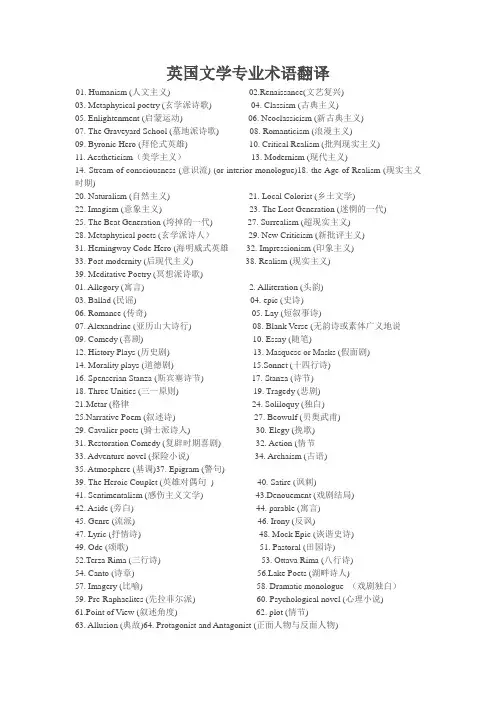
英国文学专业术语翻译01. Humanism (人文主义) 02.Renaissance(文艺复兴)03. Metaphysical poetry (玄学派诗歌) 04. Classism (古典主义)05. Enlightenment (启蒙运动) 06. Neoclassicism (新古典主义)07. The Graveyard School (墓地派诗歌) 08. Romanticism (浪漫主义)09. Byronic Hero (拜伦式英雄) 10. Critical Realism (批判现实主义)11. Aesthetic ism(美学主义)13. Modernism (现代主义)14. Stream of consciousness (意识流) (or interior monologue)18. the Age of Realism (现实主义时期)20. Naturalism (自然主义) 21. Local Colorist (乡土文学)22. Imagism (意象主义) 23. The Lost Generation (迷惘的一代)25. The Beat Generation (垮掉的一代) 27. Surrealism (超现实主义)28. Metaphysical poets (玄学派诗人)29. New Criticism (新批评主义)31. Hemingway Code Hero (海明威式英雄32. Impressionism (印象主义)33. Post modernity (后现代主义) 38. Realism (现实主义)39. Meditative Poetry (冥想派诗歌)01. Allegory (寓言) 2. Alliteration (头韵)03. Ballad (民谣) 04. epic (史诗)06. Romance (传奇) 05. Lay (短叙事诗)07. Alexandrine (亚历山大诗行) 08. Blank V erse (无韵诗或素体广义地说09. Comedy (喜剧) 10. Essay (随笔)12. History Plays (历史剧) 13. Masquesc or Masks (假面剧)14. Morality plays (道德剧) 15.Sonnet (十四行诗)16. Spenserian Stanza (斯宾塞诗节) 17. Stanza (诗节)18. Three Unities (三一原则) 19. Tragedy (悲剧)21.Metar (格律24. Soliloquy (独白)25.Narrative Poem (叙述诗) 27. Beowulf (贝奥武甫)29. Cavalier poets (骑士派诗人) 30. Elegy (挽歌)31. Restoration Comedy (复辟时期喜剧) 32. Action (情节33. Adventure novel (探险小说) 34. Archaism (古语)35. Atmosphere (基调)37. Epigram (警句)39. The Heroic Couplet (英雄对偶句) 40. Satire (讽刺)41. Sentimentalism (感伤主义文学) 43.Denouement (戏剧结局)42. Aside (旁白) 44. parable (寓言)45. Genre (流派) 46. Irony (反讽)47. Lyric (抒情诗) 48. Mock Epic (诙谐史诗)49. Ode (颂歌) 51. Pastoral (田园诗)52.Terza Rima (三行诗) 53. Ottava Rima (八行诗)54. Canto (诗章) ke Poets (湖畔诗人)57. Imagery (比喻) 58. Dramatic monologue (戏剧独白)59. Pre-Raphaelites (先拉菲尔派) 60. Psychological novel (心理小说)61.Point of V iew (叙述角度) 62. plot (情节)63. Allusion (典故)64. Protagonist and Antagonist (正面人物与反面人物)65. Flashback (倒叙) P133 66. Narration67. Ambiguity69. Symbolism (象征主义)72. Existentialism (存在主义) 73. Anti-hero (反面人物)74 . Round Character (丰满的人物) 75. Flat character (平淡的人物)76. Oedipus complex (俄狄浦斯情结/ 蛮母厌父情结)77.omniscience (无所不知的)78. Poetry (诗歌) 79. Rhyme (押韵)80. Iambic pentameter (五音步诗) 81. Rhyme royal82. Shakespearean sonnet (莎士比亚十四行诗) 83. Italian or petranrchan sonnet(意大利十四行诗)85. Poetic license (诗的破格) 86. Epiphany (主显节)87. Psychological penetration (心理透视) 88. Legend (传说)89. Myth (神话) 90. Pessimism (悲观主义)91. Jacobean age (英王詹姆斯一世时期) 92. Tragicomedy (悲喜剧)93. Comedy of manners (风俗喜剧) 94. Gothic novel (哥特式小说)95. Historical novel (历史小说) 96.Unitarianism (上帝一位论)99. Consonance (和音) 100. Free V erse (自由体诗歌)02. Theme (主题) 06. Theatre of the Absurd (荒谬剧)13. Magic realism (魔幻现实主义) 14. Analogy (类比)15. Anapest (抑抑扬格) 16. Antagonist (次要人物)17. Antithesis (对立) 18. Aphorism (格言) 20. Argument (论据) 21. Autobiography (自传) 23. Biography (传记) 26. Character (人物)27. Characterization (性格描绘) 28. Climax (高潮)29. Conflict (冲突) 30. Connotation (隐含意义)31. Couplet (对偶) 32. Dactyl (扬抑抑格)33. Denotation (意义) T 34. Denouement (结局)35. Description (叙述) 36. Diction (措词)37. Dissonance (不协和音) 38. Emblematic image (象征比喻)A verbal picture or figure with a long tradition of moral or religious meaning attached to it.44. Exposition (解释说明) 45. Fable (寓言)46. Figurative language (比喻语言) 47. Figure of speech (修辞特征)48. Foil (衬托) 49. Foot (脚注) 50. Hyperbole (夸张). 51. Iamb (抑扬格) 59. Metaphor (暗喻) 63. Motivation (动机)64. Multiple Point of View (多视角) 65. Narrator (叙述者)67. Nonfiction (写实文学) 68. Novel (小说)69. Octave (八行体诗) 70. Onomatopoeia (拟声法构词)71. Oxymoron (矛盾修辞法) 72. Paradox (自相矛盾)73. Parallelism (平行) 74. Pathos (哀婉) 75. Persuasion (说服) 76. Pictorialism (图像) 77. Pre-Romanticism (先浪漫主义) 78. Protagonist (正面人物)79. Psalm (圣歌) 80. Psychological Realism (心理现实主义) 81. Pun (双关语) 82. Quatrain (四行诗)83.Quintain (五行诗) the five-line stanza. 84. Refrain (叠句)85. Rhythm (韵律) 86. Scansion (诗的韵律分析)87. Septet (七重唱)88. Sestet (六重唱) 89. Setting (背景)90. Short Story (短篇小说) 91. Simile (明喻)。
西方文化概论名词解释
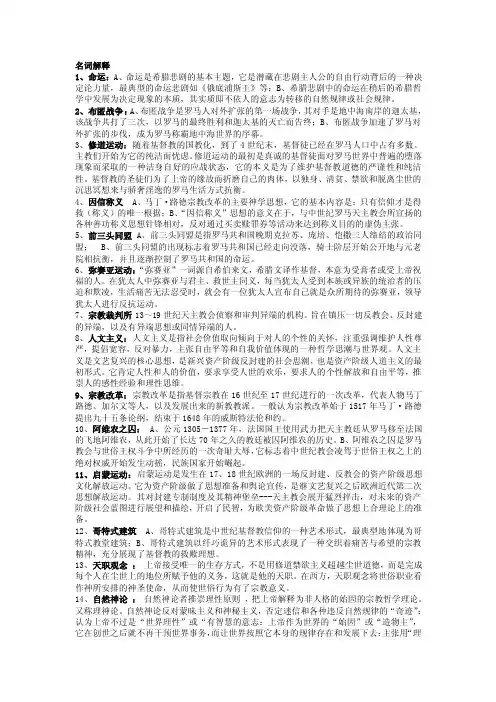
名词解释1、命运:A、命运是希腊悲剧的基本主题,它是潜藏在悲剧主人公的自由行动背后的一种决定论力量,最典型的命运悲剧如《俄底浦斯王》等;B、希腊悲剧中的命运在稍后的希腊哲学中发展为决定现象的本质,其实质即不依人的意志为转移的自然规律或社会规律。
2、布匿战争:A、布匿战争是罗马人对外扩张的第一场战争,其对手是地中海南岸的迦太基,该战争共打了三次,以罗马的最终胜利和迦太基的灭亡而告终;B、布匿战争加速了罗马对外扩张的步伐,成为罗马称霸地中海世界的序幕。
3、修道运动:随着基督教的国教化,到了4世纪末,基督徒已经在罗马人口中占有多数。
主教们开始为它的纯洁而忧虑。
修道运动的最初是真诚的基督徒面对罗马世界中普遍的堕落现象而采取的一种洁身自好的应战状态,它的本义是为了维护基督教道德的严谨性和纯洁性。
基督教的圣徒们为了上帝的缘故而折磨自己的肉体,以独身、清贫、禁欲和脱离尘世的沉思冥想来与骄奢淫逸的罗马生活方式抗衡。
4、因信称义A、马丁·路德宗教改革的主要神学思想,它的基本内容是:只有信仰才是得救(称义)的唯一根据;B、“因信称义”思想的意义在于,与中世纪罗马天主教会所宣扬的各种善功称义思想针锋相对,反对通过买卖赎罪券等活动来达到称义目的的虚伪主张。
5、前三头同盟A、前三头同盟是指罗马共和国晚期克拉苏、庞培、恺撒三人缔结的政治同盟;B、前三头同盟的出现标志着罗马共和国已经走向没落,骑士阶层开始公开地与元老院相抗衡,并且逐渐控制了罗马共和国的命运。
6、弥赛亚运动:“弥赛亚”一词源自希伯来文,希腊文译作基督,本意为受膏者或受上帝祝福的人。
在犹太人中弥赛亚与君主、救世主同义,每当犹太人受到本族或异族的统治者的压迫和欺凌,生活痛苦无法忍受时,就会有一位犹太人宣布自己就是众所期待的弥赛亚,领导犹太人进行反抗运动。
7、宗教裁判所13~19世纪天主教会侦察和审判异端的机构。
旨在镇压一切反教会、反封建的异端,以及有异端思想或同情异端的人。
专有名词翻译
1.四大发明the four great inventions of ancient China2.火药gunpowder3.印刷术printing4.造纸术paper-making5.指南针the compass6.四书the four books7.中国画traditional Chinese painting8.书法calligraphy9.水墨画Chinese brush painting ,ink and wash painting10.工笔traditional Chinese realistic painting11.孙子兵法The Art of War12.汉字Chinese characters13.华夏祖先the Chinese ancestors14.中国武术kung fu15.武术门派styles or schools of martial art16.习武健身practice martial art for fitness17.气功qigong, deep breathing exercises18.拳击boxing19.中国文学Chinese literature20.重要文化遗产major cultural heritage21.优秀民间艺术outstanding folk arts22.文物cultural relics23.中国结Chinese knot24.旗袍cheongsam25.朝廷使者royal court envoy26.文人men of letters27.雅士refined scholars28.表演艺术performing art29.工艺,手艺workmanship/craftsmanship30.阳历solar calendar31.阴历lunar calendar32.闰年leap year33.二十四节气the twenty-four solar terms34.十二生肖zodiac35.传统节日traditional holidays36.春节Spring Festival37.元宵节Lantern Festival38.清明节Qingming Festival39.端午节Dragon Boat Festival40.中秋Mid-Autumn Festival41.重阳节Double ninth Day/the Aged Day42.秦始皇帝Emperor Qinshihuang,China`s first emperor43.才子佳人gifted scholars and beautiful ladies44.文明摇篮cradle of civilization。
西方文化的部分名词解释
西方文化的部分名词解释名词解释1、表现主义:表现主义这一概念最初运用在绘画评论,后来用于文学艺术各领域,表现主义是一种反传统的现代主义流派,在各种艺术形式中均有表现,其特征为思想上不满社会现实,创作上不满足于对客观事物的摹写,要求进而表现实物的内在实质,在表现手法上,强调主观想象,强调幻象在文学想象力中的作用。
2、营造幻象:是卡夫卡小说创作的方法与特点,在总体上呈现出一个超现实的世界,一个想象的梦幻的世界,一个并不存在的荒诞的世界,这个幻象的世界看似不合逻辑但却并非虚妄,揭示了人类自下而上更本真的图景。
3、虚拟现实:也是卡夫卡小说创作的方法和特点,他的小说擅长营造一种在生活中完全不可能存在但又有逻辑上的存在可能性的现实情景,是未必发生却可能发生的情境。
4、意识流:包含的意思可以指一个现代主义的流派,指一种小说文体,指表现人物心理和意识活动的一种技巧。
5、意识流小说:意识流小说是20世纪初期在欧美文坛上出现的一个文学流派,它的哲学基础是法国现代哲学家亨利*柏格森的直觉主义和心理时间观,它的心理学基础是奥地利心理学家弗洛伊德的精神分析说。
6、心理时间:是法国哲学家柏格森提出的理论,他的哲学中的“时间”不是通常理解的体现在钟表刻度上的物理时间,而是一种心理意义上的时间。
7、内心独白:内心独白是意识流小说中表现人物心理和意识活动的一种最常用也最重要的技巧,是人物内心无声无息的的语言意识的表达。
8、自由联想:自由联想指在小说中,人物的意识流程往往不具有任何规律和秩序。
“蒙太奇”。
蒙太奇是电影的基本手法,通常指电影镜头的组合、叠加。
而意识流小说中蒙太奇的运用指的则是作者把不同时间和空间中的事件和场景组合拼凑在一起,从而超越了时间和空间的限制,表现了人的意识跨越时空的跳跃性与无序性。
意识流小说中的蒙太奇进一步分为时间蒙太奇与空间蒙太奇两种。
9、存在主义:存在主义文学出现在第二次世界大战前夕的法国,战后形成了高峰,存在主义文学作品表现的是存在主义的哲学思想,“自由选择”及“荒诞体验”是其重要的观念和基本主题,存在主义文学的显著特征是哲理化。
西方文化的名词解释
西方文化的名词解释西方文化是指起源于古希腊罗马古代文明,并随后在欧洲各国演化发展的文化体系。
它与东方文化存在明显的差异,包括价值观、社会结构、艺术风格等方面。
下面将对一些西方文化中常见的名词进行解释,帮助读者更好地了解西方文化的内涵和特点。
1. 文艺复兴(Renaissance)文艺复兴是指发生在15至16世纪的欧洲文化运动,它标志着中世纪的萧条状态被打破,重新唤起了对古典文化的兴趣。
艺术家、学者和人文主义者开始研究古希腊罗马时期的文化,尤其是其艺术和哲学思想。
通过对人体解剖、透视和光影的研究,文艺复兴艺术家创造了以真实主义和立体感为特点的艺术风格。
2. 启蒙运动(Enlightenment)启蒙运动是指18世纪欧洲兴起的一场思想运动,它强调理性和科学,反对封建制度和宗教束缚。
启蒙思想家们主张人类通过理性思考和科学方法来解决问题,提倡个人权利、言论自由和民主制度。
这一运动对后世的西方社会和政治体系产生了深远影响。
3. 工业革命(Industrial Revolution)工业革命是指从18世纪中叶开始发生在英国的一场重大变革。
它以机械化和大规模生产为特征,从而彻底改变了人类生活和经济结构。
工业革命使得工业生产、交通运输和技术进步大幅提升,推动了城市化和全球化进程,也衍生出了新的社会问题和阶级矛盾。
4. 民主(Democracy)民主是指一种政治制度,其中政权由公民通过选举或其他参与形式来共同决策。
民主强调个人权利、法律平等和政府责任,代表了一种人民参与政治的方式。
西方文化中的民主制度包括议会制、总统制和宪政制度等。
5. 科学方法(Scientific Method)科学方法是一种通过观察、实验和推理来获得科学知识的方法论。
它强调实证和可重复性,将科学知识从主观偏见和信仰中解放出来。
科学方法的应用推动了现代科学的发展,使得人类对自然和社会世界的认识更加准确和深入。
6. 个人主义(Individualism)个人主义是一种价值观和社会理念,强调个体的自由、独立和个人权利的尊重。
西方文明史术语(罗马)
Etruscan英[ɪ'trʌskən] 美[ɪ'trʌskən] n.伊特鲁里亚人Latium [历史]拉丁姆(古意大利罗马东南地区)pastoral英[ˈpɑ:stərəl] 美[ˈpæstərəl] adj.牧师的,主教的;urbanization英[ˌɜ:bənaɪ'zeɪʃn] 美[ˌɜ:bənaɪ'zeɪʃn] n.都市化Romulus英[ˈrɔmjuləs] 美[ˈrɑmjələs] n.<罗神>罗穆卢斯(战神Mars之子)罗慕路斯(Romulus,约前771年出生,约前717年逝世)与雷穆斯(Remus,约前771年出生,约前753年逝世)是罗马神话中罗马市的奠基人。
在罗马神话中他们是一对双生子。
Remus英[ˈri:məs] 美[ˈriməs] n.<罗神>瑞摩斯(战神Mars之子)patrician英[pəˈtrɪʃn] 美[pəˈtrɪʃən] adj.贵族的n.贵族;有教养的plebeian英[pləˈbi:ən] 美[plɪˈbiən] n.平民;庶民;consul英[ˈkɒnsl] 美[ˈkɑ:nsl] n.领事;assembly英[əˈsembli] 美[əˈsɛmbli] n.装配;集会senate英[ˈsenət] 美[ˈsɛnɪt] n.元老院executive officer英[ɪgˈzekjətɪv] 美[ɪɡˈzɛkjətɪv] n.总经理;行政部门-praetor英['pri:tə] 美['pri:tə] n.执政官,长官quaestor英['kwi:stə] 美['kwestə] n.刑事推事,主管财务官吏tribune英[ˈtrɪbju:n] 美['trɪbju:n] n.论坛;(古罗马)护民官;民众领袖;confederation英[kənˌfedəˈreɪʃn] 美[kənˌfɛdəˈreʃən] n.联盟;结盟;同盟国Carthage英[ˈkɑ:θidʒ] 美[ˈkɑrθɪdʒ] n.迦太基(非洲北部,今突尼斯的奴隶制城邦,腓尼基人所建,公元146年被罗马帝国所灭,见Punic Wars)captive英[ˈkæptɪv] 美[ˈkæptɪv] n.战俘,俘虏;被the Twelve Tables十二铜表法也叫十二表法,是古罗马国家立法的纪念碑,也是最早的罗马法文献。
- 1、下载文档前请自行甄别文档内容的完整性,平台不提供额外的编辑、内容补充、找答案等附加服务。
- 2、"仅部分预览"的文档,不可在线预览部分如存在完整性等问题,可反馈申请退款(可完整预览的文档不适用该条件!)。
- 3、如文档侵犯您的权益,请联系客服反馈,我们会尽快为您处理(人工客服工作时间:9:00-18:30)。
Nouveau Roman
新小说派
Existentialism
存在主义
The Theatre of the absurd
荒诞剧
Black Humor
黑色幽默
Catch-22
第二十二条军规
Fauvism
野兽派
Expressionism
表现主义
Cubism
立体主义
Futurism
未来主义
Dadaism
holy communion
圣餐
The Crusades
十字军东征
Carolingian Renaissance
加洛林复兴
Alfred the Great
阿尔弗雷德大帝
National Epic
民族史诗
Beowulf
贝奥武甫
Song of Roland
罗兰之歌
The Divine Comedy
神曲
The Canterbury Tales
为米罗辩护
ProSestio
为塞斯提乌斯辩护
Cleopatra
克里欧佩特拉
Julius Caesar
尤里乌斯凯撒
Commentaries
高卢战记
Lucretius
卢克来修
On the Nature of Things
物性论
TheAeneid
埃涅阿斯纪
The Pantheon
万神殿
Pont duGard
现代主义
Id
本我
Ego
自我
superego
超我
Oedipus Complex
俄狄浦斯情节,恋母情节
The Waste Land
荒原
Ulysses
尤利塞斯
The Lost Generation
迷失一代
Hemingway
海明威
The Beat Generation
垮掉的一代
Angry Young Men
Exodus
出埃及记
Noah’s Ark
诺亚方舟
The prophets
先知
The Book of Daniel
但以理书
The Edict of Milan
米兰赦令
The four accounts in the New Testament
四福音书
King James’ version of Bible
耶稣会
Don Quixote
唐吉可德
William Shakespeare
威廉莎士比亚
Columbus
哥伦布
Copernicus
哥白尼
Kepler’sLaws
开普勒定律
the laws of gravitation
万有引力
the Great Instauration
伟大复兴
Inductive method
Aphrodite
阿佛洛狄忒
Venus
维纳斯
Constantine
康斯坦丁
Byzantium
拜占庭
Constantinople
君士坦丁堡
Turks
土耳其人
MarcusTulliusCicero
马尔库斯图留斯西塞罗
Ciceronian
西塞罗风格
DeLegibus
论法律
DeOfficus
官吏论
ProMilone
论法的精神
Rousseau’sThe Social Contract
卢梭社会契约论
Henry Fielding
亨利费尔丁
Faust
浮士德
Wilhelm Tell
威廉退尔
The Viennese School
维也纳乐派
Romanticism
浪漫主义
Byronic hero
拜伦式英雄
LesMiserables
陶立克式
PaxRomana
罗马和平
Virgil
维吉尔
Agamemnon
阿加迈农
Homer
荷马
Sappho
萨福
Pindar
品达
Lesbos
莱斯博斯岛
Aeschylus
埃斯库罗斯
Prometheus Bound
被缚的普罗米修斯
Persians
波斯人
Sophocles
索福克勒斯
Oedipus the King
诗学
Rhetoric
修辞学
Sophists
诡辩家
Protagoras
普罗塔格拉
The Cynics
犬儒哲学派
TheSceptics
怀疑论者
The Epicureans
伊壁鸠鲁学派
Euclid
欧几里得
Archimedes
阿基米德
Ionic style
爱奥尼亚式
Corinthian style
科林斯柱式
Greco-Roman element
希腊罗马元素
Judeo-Christian element
犹太基督教元素
Iliad
伊里亚特
Odyssey
奥德赛
Herodotus
希罗多德
Socrates
苏格拉底
Dialecticalmethod
辩证法
Plato
柏拉图
Diogenes
狄奥艮尼
Stoics
斯多哥派
Doric Style
圣汤玛斯阿奎那
Scholasticism经来自哲学Roger Bacon
罗杰培根
Experimental Science
实验科学
Dante Alighieri
但丁
Geoffrey Chaucer
杰弗里乔叟
Romanesque
罗马式建筑
Renaissance
文艺复兴
Humanism
人文主义
LeonardodaVinci
归纳法
Thomas Hobbes’s political thought
霍布斯的政治思想
Lock’s Social Contract
洛克的社会契约论
The English Revolution
英国革命
The Glorious Revolution
光荣革命
The Bill of Rights
权利法案
Descartes’ Theory of Knowledge
钦定版本圣经
Fall of Man
人的堕落
Ten Commandments
摩西十诫
Book of Joshua
约书亚书
Book of Judges
士师记
Book of Samuel
撒母耳记
Books of Kings
列王记
Books of the Chronicles
历王记
Book of Ezra
以斯拉书
达达派
Book of Nehemiah
尼希米记
Book of Job
约伯记
Book of Psalms
诗篇
Ecclesiastes
旧约传道书
Song of Solomon
所罗门之歌
Amos
阿摩司
Jeremiah
耶利米
Matthew
马太
Mark
马克
Luke
路加
John
约翰
Crucifixion
耶稣钉死在十字架上个的画
TheParthenon
帕特农神庙
The Acropolis at Athens
雅典卫城
Discus Thrower
掷铁饼者
Venus de Milo
米罗的维纳斯
Laocoongroup
拉奥孔
Black-figurepaintings
黑彩绘画
Red-figure paintings
红彩绘画
Byron’s Isles of Greece
Maron
马龙
Sons ofOrsiphantes
欧尔喜庞司之子
Thespians
塞士比斯之徒
Dithyrambus
狄图拉姆波斯
Son ofHarmatides
哈尔玛提戴斯之子
Leodidas
莱奥尼达斯
Peloponnese
伯罗奔尼撒
Thucydides
修昔底德
Syracuse
锡拉库扎
Macaulay
拜伦《哀希腊》
Shelley’s Hellas
雪莱《海勒斯》
Prometheus Unbound
解放的普罗米修斯
Keats’s Ode on a Grecian Urn
济慈《希腊古瓷颂》
Corinth
科林斯
citizen-assembly
公民大会
servility
奴性
Zeus
宙斯
Jupiter
朱庇特
悲惨世界
EngeneOnegin
叶普盖尼奥涅金
Romantic Music
浪漫主义英雄
Surrealism
超现实主义
Realism
现实主义
The Human Comedy
人家喜剧
Naturalistic Novel
自然主义小说
Ibsen
易卜生
Impressionism in Art
印象派
Modernism
坎特伯雷故事集
Gothic
哥特式建筑
